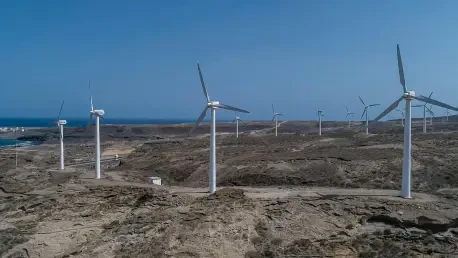Maryland’s energy landscape is facing a turbulent storm as the Trump administration imposes significant barriers to offshore wind development, a cornerstone of the state’s renewable energy ambitions, stalling critical projects and casting doubt on the future of green initiatives in the region. This federal rollback, which includes revoking millions of acres designated for wind energy, has created uncertainty at a time when the state grapples with surging electricity demands driven by cutting-edge technologies like artificial intelligence (AI) and expansive data centers, all while relying on an aging power grid teetering on the brink of failure. The specter of blackouts looms large, especially in areas like Baltimore, where emergency measures have become necessary to maintain stability. This intricate web of policy shifts, infrastructure challenges, and rising needs places Maryland at a critical crossroads, raising pressing questions about how to balance immediate energy reliability with long-term sustainability goals in the face of federal opposition.
Federal Roadblocks to Renewable Progress
The Trump administration’s recent policy shift has dealt a severe blow to Maryland’s aspirations for a cleaner energy future, fundamentally altering the trajectory of offshore wind development. On July 30 of this year, the Bureau of Ocean Energy Management (BOEM) announced the revocation of over 3.5 million acres of unleased federal waters previously earmarked for wind energy projects in the Central Atlantic region near Maryland. This decision reflects a prioritization of other national interests over renewable energy expansion, creating a ripple effect of uncertainty across the state’s green initiatives. Such a move not only disrupts long-standing plans to reduce carbon emissions but also undermines the confidence of stakeholders who have invested time and resources into these projects. The implications are profound, as Maryland’s ability to meet ambitious environmental targets now hangs in a precarious balance, with federal support appearing increasingly out of reach.
Beyond the immediate policy change, the impact of this federal rollback extends to the broader renewable energy ecosystem in Maryland, stalling momentum at a critical juncture. Projects that were once viewed as linchpins of the state’s transition to sustainable power sources are now grappling with an uncertain future, as the loss of designated Wind Energy Areas (WEAs) deters potential investors. The chilling effect on funding and development timelines cannot be overstated, as private entities hesitate to commit to initiatives without clear federal backing. Moreover, this shift exacerbates existing tensions between state and federal priorities, leaving Maryland officials to navigate a complex landscape where their environmental goals are at odds with national policy directives. The resulting deadlock threatens to delay the state’s progress toward reducing reliance on fossil fuels, highlighting the urgent need for alternative strategies to keep renewable ambitions alive despite these significant hurdles.
Economic Fallout from Stalled Initiatives
Among the most tangible consequences of the federal halt on offshore wind is the stagnation of key projects like US Wind’s proposed 114-turbine installation off Ocean City, which now faces an uncertain path forward. Despite securing a state permit, the project has been mired in delays due to the shifting federal landscape, with progress slowed to a near standstill. This setback not only hampers Maryland’s renewable energy output but also casts a shadow over the state’s commitment to transitioning away from traditional power sources. The broader implications for public perception and trust in government-led green initiatives are concerning, as repeated delays risk eroding support for such projects. With each passing month of inaction, the gap between Maryland’s environmental promises and actual outcomes widens, creating a challenging environment for advocates of sustainable energy solutions.
Equally troubling is the unfulfilled economic potential tied to these stalled wind projects, which were expected to bring significant job growth and investment to the region. A prime example is the planned wind turbine manufacturing facility at Tradepoint Atlantic in Edgemere, which was projected to employ 550 workers by the current year but remains largely dormant. The absence of activity at this site underscores the broader economic fallout from federal policy changes, as promised boosts to local economies fail to materialize. This situation frustrates communities that were banking on new employment opportunities and economic revitalization, while also highlighting the fragility of renewable energy commitments in the face of external disruptions. As Maryland struggles to reconcile these broken promises with ongoing energy needs, the economic dimension of the offshore wind halt emerges as a critical area of concern for policymakers and residents alike.
Rising Energy Needs and Grid Vulnerabilities
Maryland’s energy challenges are further intensified by a dramatic increase in electricity demand, driven by the rapid adoption of advanced technologies such as AI and the proliferation of data centers across the state. These modern developments require substantial power, placing unprecedented pressure on an infrastructure that was not designed to handle such loads. The regional grid operator, PJM Interconnection, has sounded the alarm on the risk of blackouts, particularly during peak demand periods exacerbated by extreme weather events. This growing mismatch between supply and demand reveals a systemic vulnerability in Maryland’s energy framework, where the pace of technological advancement has outstripped the capacity of existing systems. Addressing this imbalance remains a pressing priority as the state seeks to avoid widespread disruptions that could impact both residents and businesses.
The fragility of Maryland’s aging power grid adds another layer of complexity to the unfolding energy crisis, as outdated infrastructure struggles to meet contemporary needs. Many of the state’s power facilities are ill-equipped to handle the surges in demand, leading to heightened concerns about reliability during critical times. PJM Interconnection’s warnings underscore the potential for rolling blackouts if immediate action is not taken, painting a grim picture of an energy landscape on the brink of collapse. This situation forces a difficult reckoning for state officials, who must balance the pursuit of long-term renewable solutions with the urgent need to shore up existing systems. The strain on the grid serves as a stark reminder that Maryland’s energy future hinges not only on policy decisions but also on the physical capacity to deliver power when and where it is needed most.
Emergency Actions Amidst Crisis
In response to the imminent threat of power shortages, federal authorities have taken drastic measures to stabilize Maryland’s grid, revealing the severity of the current energy predicament. On July 28 of this year, U.S. Energy Secretary Chris Wright granted an emergency waiver allowing the H.A. Wagner power plant at Brandon Shores to exceed environmental pollution limits for 90 days. This temporary exemption ensures grid stability in the Baltimore region, averting the immediate risk of blackouts during peak demand. However, it also highlights a troubling reliance on outdated fossil fuel plants, which conflicts with the state’s broader environmental objectives. Such stopgap solutions, while necessary in the short term, expose the underlying tension between maintaining energy reliability and adhering to sustainability commitments, creating a challenging dynamic for Maryland’s energy strategy.
The reliance on emergency waivers to prevent blackouts further underscores the gap between Maryland’s renewable energy aspirations and the harsh realities of its current infrastructure capabilities. While the waiver for the H.A. Wagner plant provides a temporary reprieve, it comes at the cost of increased pollution, raising questions about the long-term environmental consequences of such measures. This situation illustrates the difficult trade-offs state and federal officials must navigate as they attempt to keep the lights on while grappling with systemic limitations. The broader takeaway is that Maryland’s energy challenges cannot be resolved through short-term fixes alone; a more comprehensive approach is needed to address both immediate grid stability and the overarching goal of transitioning to cleaner power sources. Until such a strategy emerges, the state remains caught in a cycle of reactive measures that fail to tackle the root causes of its energy woes.
Political Tensions and Diverging Views
The federal decision to halt offshore wind development has ignited significant political friction within Maryland, exposing deep divides over the state’s energy direction. Governor Wes Moore, alongside officials like Department of the Environment Secretary Serena McIlwain, continues to champion the pursuit of cleaner energy, emphasizing the need for adaptability in the face of federal obstacles. Their stance reflects a commitment to long-term sustainability, even as immediate progress is stymied by policy setbacks. This determination to push forward with green initiatives, despite the challenges, signals a belief in the transformative potential of renewable energy for Maryland’s future. However, the lack of federal support complicates these efforts, creating a contentious environment where state ambitions are repeatedly tested against external constraints.
In stark contrast, critics such as Republican Delegate Ryan Nawrocki from Baltimore County have voiced sharp opposition to the state’s focus on offshore wind, framing it as a misguided and failing endeavor. Nawrocki and like-minded skeptics warn of an impending “energy cliff,” attributing potential grid failures to what they describe as ill-conceived green policies that prioritize idealism over practicality. This perspective argues for a reevaluation of Maryland’s energy strategy, advocating for greater emphasis on reliable, traditional power sources to prevent disruptions. The clash between these opposing viewpoints mirrors a larger national debate on how to reconcile environmental goals with energy security, positioning Maryland as a microcosm of this broader struggle. As political divisions deepen, finding common ground remains elusive, complicating efforts to chart a cohesive path forward for the state’s energy landscape.
Navigating an Uncertain Energy Horizon
Maryland finds itself perched precariously at what many describe as an “energy cliff,” a critical juncture where the fragility of its power grid intersects with the uncertainty of federal backing for renewable projects. Stakeholders across the spectrum—state leaders, industry representatives, and grid operators—acknowledge the looming threat of power shortages, particularly during periods of high demand. Yet, consensus on a solution remains frustratingly out of reach, with opinions split between doubling down on green energy and prioritizing immediate reliability through conventional means. This lack of agreement underscores the complexity of Maryland’s predicament, as the state must navigate a maze of policy, infrastructure, and technological challenges to secure a stable energy future without sacrificing its environmental commitments.
Looking ahead, the path forward for Maryland demands innovative thinking and strategic adaptability to bridge the gap between short-term energy needs and long-term sustainability goals. State leaders have advocated for resilience, pushing for alternative approaches to renewable development despite federal opposition, while industry voices remain committed to delivering on wind projects despite the setbacks. The urgency of modernizing the grid to accommodate rising demand from tech-driven sectors cannot be ignored, nor can the risk of blackouts if immediate action falters. Maryland’s experience serves as a cautionary tale for other regions wrestling with similar issues, highlighting the need for a balanced framework that integrates emergency preparedness with visionary planning. As discussions evolve, it becomes clear that collaborative efforts and bold investments are essential to prevent the state from tipping over the energy cliff it has so narrowly avoided.









